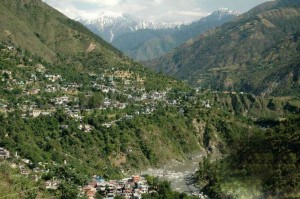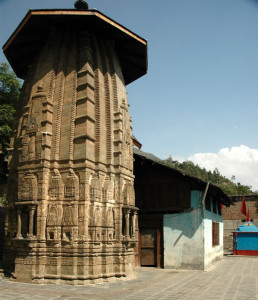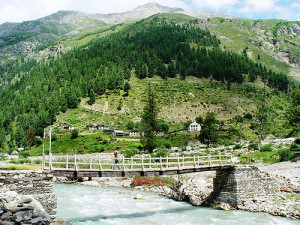Chamba is a small hill station, valley and is a small town located at an altitude of 926 metres. Chamba is the perfect place for those who want to unwind their hectic schedule and enjoy a peaceful stay in the hills. Chamba is situated amidst the Shivalik hills, in the north western part of Himachal Pradesh. The town lies on River Ravi, in a valley between two mountain ridges. Chamba provides a very vast contrasts to Dalhousie, the colonial resort of rich Lahorians and the British, because of its undisturbed ancient heritage and customs. Chamba is a place where in one moment you will fell like being on a hill top, while the next will take you higher to the clouds. Come to Chamba to feel the transition form real life to a magical one. Chamba is easily accessible due to its proximity at just 50 km from Dalhousie via Khajjiar.
This Rajput capital has temples that form the main highlight, attracting thousands of pilgrims as well as tourist all the year round. The growing town has also extracted its pound of flesh, from the temple that are located in a maze of by lanes. Being one of the most beautiful hill resorts of Himachal, it is an indisputable fact, that the landscape is sure to delight even an ill-favored spectator. Visit this temple hill station during the month of March and June, when the weather is typically highland – cool and pleasant. There are local fairs and festivals that too drive tourists to home this destination – where they get a chance to fuse with the local culture and traditions.History asserts the Rajput to have been the main rulers of this small hill town since the 6th century AD. Though a multitudinous cultural effect could have been in vogue in Chamba, but over the years the influx of plains people has changed both the topography and ethnographic profile of this ancient Rajput capital.
Chamba tourist attractions:
In reality, Chamba has no rival for its scenic beauty. It is my favorite place in whole Himachal. The most attractive thing which pulls me towards Chamba is the high cultured society of Chamba. Tourism in Chamba offers everlasting memories of a place that is so beautiful yet so easily accessible. If you stay here for a few days, you feel like you have spent a whole year and this is the key quality of Chamba as far as tourism in Chamba is concerned.
Kailash Manimahesh :
( 4,170 metres ) Mani-Mahesh is 28 kms. from Bharmour. During mela days efficient bus service is available upto Hadsar. This lake is supposed to be blessed by goddess Kali and protected by Lord Shiva. Thousands of pilgrims journey here to bathe in its sacred water, on the fifteenth day, following the festival of Janamashtami. A fair is held every year at this lake during the month of August or September. This is the must seen place in Chamba.Bhuri Singh Museum :
Bhuri Singh Museumis one of the oldest museums in India. It was set up in September 1908 by the Raja Bhuri Singh under the guidance and inspiration of venerable historian of Indian Art Professor John Philip Vogel. It is on the world art map because of its finest collection of Pahari miniature paiting chieflu Chamba and guler Kangra styles. Apart from the paintings, the museum houses a large collection of epigraphs, copper plates, historical documents, manuscripts, sculptures in stone, metal and wood, Chamba rumals, coins, murals, wood carvings, armour and other decorative arts. Opens daily from 10:00 A.M. to 5:00 P.M. except on Monday and gazetted/local holidays. Lunch time is 1:30 P.M. to 2:00 P.M. It is also open on Sunday.Chamba Chaugan :
A public promenade – a grassy maidan less than 1 km. in length and about 75 metres wide. It is a busy local trading centre for villagers from the surrounding hills. Each year Chaugan is the site for the Minjar procession ( Minjar Mela ). The fair lasts for a week and people attend the fair in the Minjar procession. The fair lasts for a week and people attend the fair in the local customs and colorful dresses, in a gay mood walking in the Chaugan where a large number of sports and cultural activities take place to commemorate this occasion. On the conclusion of fair the “Minjars” are immersed into the Ravi river. It is also an establishment base for various exciting treks into the valley around.Chamba Town :
Located on the banks of the Ravi river the township resembles an Italian village fortress. The weather of Chamba is always pleasant, not too cold and not too hot because of its typical height of 1006 meters from mean sea level. A gentle cool breeze is refreshing the whole town at intervals. There are many famous places around Chamba Town. Chamba is known for its streams, meadows, temples, paintings, rumal ( handkerchief ) and lakes. Chamba Town sometimes experiences snowfall during winter that adds to the beauty of Chamba Town. The people of Chamba are very helpful and innocent. Chamba Town is also the main market for many villages from near and far.Laxmi Narayan Temple Chamba :
Laxmi Narayana Temple, which is the main temple of Chamba town was built by Sahil Varman in the 10th century AD. The temple has been built in the Shikhara style. The temple consists of Bimana i.e. Shikhara and GarbhGriha with a small antralya. Laxmi Narayana Temple has a mandapa like structure also. The wooden Chhattries, the shell roof, atop the temple were in response to the local climatic conditions as a protection against snowfall. There are several other temples within the complex. The temple of Radha krishna, Shiva Temple of Chandergupta and Gauri Shankar Temple are among these.Chamunda Devi Temple :
This temple is located on the spur of the Shah Madar Hill overlooking the town to its south east. The temple stands on a raised platform. The temple has artistic carvings on its lintel, pillars and the ceiling. Behind the main temple is a small shrine of Lord Shiva in the Shikhara style. There is another platform in front of this temple where two very old peepul trees provide shelter to the visitors. From this platform a bird’s eye view of most of the land marks in the town including Chaugan, Circuit House, most of the temples and river Ravi can be had. The temple is being looked after by Archaeological Survey of India. This temple can be approached by road from Chamba ( 3 km. ). The temple is an ideal picnic spot throughout the year because it has an easy approach and a commanding view.Hari Rai Temple : This temple is dedicated to Lord Vishnu and dates back to 11th century. It was probably built by Salabahana. This temple lies in the north-west corner of the main Chaugan, which had became the official entrance to the town by the end of 19th C. A steep path leads to the old Shitla bridge, which was constructed in the year 1894. The temple is built in Shikhara style and stands on a stone platform. The Shikhara of the temple is finely carved. This is one of the major old temples, which is away from the old township and the only one near the Chaugan.
Chamba Church : Situated in the main Chamba market is the beautiful Chamba Church. This Church was erected by Raja Sham Singh and gifted to the church of Scotland mission for the use of the christian community in Chamba. Its foundation stone was laid on 17th February, 1899 A.D. and its work was finished in 1905 A.D.
Champavati Temple :
This temple is located behind the City Police Post and Treasury building. This temple was built by Raja Sahil Varman in memory of his daughter Champavati who is believed to have influenced her father to set-up Chamba at its present location. The temple is in the Shikhara style with elaborate stone carving and the wheel roof. The size of this temple is equivalent to the largest of the Laxmi Narayana Temple.Chamba Library : Inside the Government College of Chamba is the old Chamba library. You can find books on almost every topic of Himachal Pradesh here, i.e. Himachal history, geography, states, books explaining ancient art and culture along with photographs of ancient coins, armour etc. If you are interested in the monuments, manuscripts, ornaments, wooden articles of utilities etc., found in the Bhuri Singh Museum, then you must visit Chamba Library. Here you can find truck loads of books on these topics. There is also an office situated near the library and you can find various books on other topics here. And not to mantion, you can also find mystery-thriller and adventurous novels of various writers here.
Suhi Mata Temple : According to a legend, the Chamba town had no convenient water supply. And therefore the Raja had a water course made from the Sarohta stream, but somehow the water refused to enter the channel made for it. It was ascribed to supernatural causes. The Saints advised that the spirit of the stream must be tranquilized and victim must be either Rani ( Queen ) or her son. The Rani named ‘Naina Devi’ got ready to sacrifice herself. Accompanied by her maidens and bare-headed as for ‘Sati’, she was taken to the spot near the village of ‘Balota’, where Rani was buried alive. The legend goes on to say that when the grave was filled in, the water began to flow and has ever since flowed abundantly. A shrine was constructed at the top of thehill by Raja in her memory. A fair called ‘Suhi Mela’ is also held in her memory from 15th of Chait to the 1st of Vaishakh, where only women and children are allowed to participate.
Bharmaur : ( 2,195 metres ) 65 km. ) Bharmour was the original capital of the state of Chamba. It has several ancient temples and monuments that reflect its erswhile glory. Some of the important temples are of – Manimahesh, Lakshna Devi, Ganesh and Nar Singh. This region is also home to Semi-nomadic Shepherds, the Gaddis. Once called Brahmpura, still retains its 84 ( Chaurasi ) ancient temples and the monuments of its one time glory, some of which date back to the 7th century A.D.
Chaurasi Temples :
The main complex have temple of Lakshana Devi, Ganesha, Manimahesh and Narsingha. According to a legend, 84 Yogi’s visited Bharmaur during the region of king Sahil Verman. Pleased with the king’s humanity and hospitality, the yogis blessed the king with ten sons and a daughter Champawati. The temples dating back to the 9th century, are one of the most important early Hindu Temples in Chamba valley. The distant of 65 km. from Chamba to Bharmaur is covered by road. Special buses ply only during Chhari Yatra days in September.Lama Dal lake : Held sacred to Lord Shiva, this lake lies amidst bare rock. ‘Lama Dal’ means a long lake. It is in the inner slopes of Dhauladhar range. This is a group of seven lakes, the largest of all is Lama Dal. It is 20 km from Dainkund (Dayankund). It is said to have unknown depth.
Pangi Valley :
This range of the Himachal in the Mid-Himalaya called Pir Panjal by geologists and Pangi Range by common people. It is the direct continuation of the main Himalayan axis entering the Himachal on the East of Bushahr. After dividing Kullu from Lahaul-Spiti, it enters Chamba territory on the Western border of Bara Banghal and traverses the district for more than sixty miles. This range divides Chamba into two unequal sections and separate these from each other to such an extent that even in the summer there is comparatively little inter communications. The Northern or smaller section called Pangi and Chamba-Lahaul, is then completely isolated from the outer world.Chowari Jot Chowari Pass : Chowari jot is almost midway between Chamba and Chowari. As you cross this pass, you will see the gorgeous Khajjiar on one side and Kainthli Dhar-slopes bristling with Pine and Deodar trees. What’s unusual about this is that you will actually be travelling on hills that are covered with snow on one side and with greenery on the other! Quite startling to see. Chowari Pass is 8000 feet above sea level and is often blocked with snow. If you come during summer-that’s April to May, you can see Rhododendron trees all around you which is a treat in itself. You’ll also see the local Gaddi tribes as they walk across this path often. And in fact, this is a good place to trek and to catch an unforgettable sunset! Take the pass at least for the thrilling drive across impossibly narrow roads and the stomach clenching drops to the bottom!
Dayanand Math Chamba : The Dayanand Math is based on the teachings of the Arya Samaj. It was founded in 1970 and is today a great religious centre. When it was first built Julhakri, its location was absolutely abandoned and unheard of. Swami Sarvanand Maharaj of Punjab is its founder, but the running of the Math was given over to his disciple Swami Sumedhanand. There is also a Sanskrit College here as well as a school, an Ayurvedic Pharmacy and a Vedic Library.
Akhand Singh Museum: Named after Raja, Bhuri Singh of chamba this is a treasure house of chamba’s rich past. The exhibits include copper plates murals, doorways costumes painting dressed stone structure with lancet windows.
Chamba Fair and festivals
Baisakhi or Bisoa : It is knows as Bisowa in Kangra, Bissue in Shimla hills and Lisshoo in Pangi-Chamba. This festival is generally celebrated on 13th of April. Preparation for the festival starts much early. The houses are white washed. People take holy dip at Haridwar, Tattapani near Shimla, Banganga near Kangra, Markanda near Bilaspur. During day time, Baisakhi fair is held at many places with traditional gaiety and attraction. Women’s participation in large number add special color to the festive mood of the people.
Hori : This festival is celebrated from 1st Baisakh with the same observances as are customary during the Holi; the only departure being that Hori is held at a different time. It is believed that a Raja may have died during Holi celebrations thereby necessitating the postponement of the festival for ever. Hori was celebrated with much fervour and festivity during the state regime.
Bhojri : This festival is held for two days following the Minjar fair and is frequented only by women and girls who is their gay apparel climb the flight of steps to Chamunda temple singing songs and offering flowers.
Nag Panchami : This is held on the fifth day of the dark half of Jeth as a worship of snake. Men draw picture of snakes in their houses and offer their prayer to them.
Rath Rathni : :This festival is held at the new moon of Asuj. The rath is a squre frame of wood with a piece of cloth tied round it and is prepared at the Hari Rai temple. The rathni is the figure of a women made up with clothes, and is prepared in the precincts of the Lakshmi Narayan temple. All being ready, the people throw their rakhars (Silk armlets) worn on the day of Rakhar Punya at the rath and then the rath is carried to Chaugan where it is joined by rathni which has been brought from Lakshmi Narayan temple. The two figures are made to touch each other and the bearers then rush apart. The rathni is taken to Champavati temple and the rath is carried through the town, brought back to Chaugan and torn into pieces. The festival seems to be associated with marriage and widowhood but the true significance has been lost in the haze of time.
How to reach Chamba
By Air : The nearest airport from Chamba is that of Pathankot, located at the distance of 120 kilometer, and offers facility for reaching the place by air. Flights are easily available from all the major cities, like Delhi and Chandigarh. Once dropped at Kangra, tourists can always board the buses running on regular basis, on the Chamba-Kangra route. Taxis are also easily available.
By Rail : Pathankot is the nearest railhead from Chamba, situated at the distance of around 122 kilometers. Tourist can come to Pathankot and from here, can opt for bus services or cab services, available to reach Chamba. From Pathankot, there is direct link to many big cities in India, like Amritsar, Delhi, Mumbai and Kolkata. Another option is Dalhousie, which is around 52 km from Chamba town.
By Road : The nearest bus station from Chamba is located at Chowgan. Bus service is easily available for reaching the place, from different destinations like Delhi, by road. Generally, the journey from Chamba to Khajjiar takes half and hours, to Bharmaur takes three and a half hours, to takes Dalhousie 3 hours, to Pathankot takes 6 hours and to Dharamshala takes 10 hours.
Chamba map
Himachal Pradesh, India

















